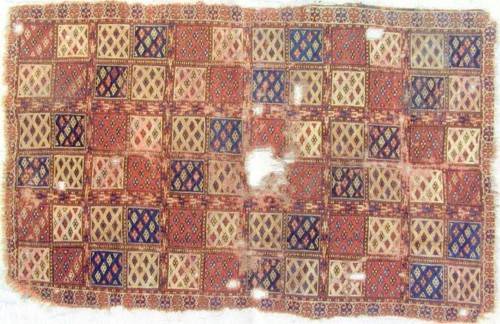| Dear folks -
Wendel and I have exchanged some messages on the side as this
discussion has gone along.
This morning, before I saw either of the images he has provided above
or that provided by Christoph Huber, I wrote Wendel saying that I had
taken a quick tour of some of my Turkmen rug books last night and that the
closest rug I could find to mine was one in Hans Konig's article toward
the back of the Macke/Thompson catalog. That photo is a black and white
image of the first piece that Wendel has posted in color above.
Konig says that this piece is an example of second of four Ersari
design groups that he identifies. Here is his description of this group:
"...The second design or quasi-tribal group includes large main carpets
which are Turkman in feeling, color and design but whose patterns do not
conform to the criteria usually accepted for tribal main carpets. Guls are
either entirely absent or are arranged differently from those in Tekke or
Saryk rugs, for example. Diamond forms, lattic patterns, and compartments,
(Figure 58 [ed., the first of Wendel's images]) occur often in this group,
reminding the observer of certain Yomut or Chodor carpets with similar
design composition..."
This last sentence has a footnote which reads:
"The execution of this compositional scheme and the resulting visual
impression are, of course, in the case of the Yomut and Chodor carpets,
different from those of the Ersari carpets."
It's a bit infuriating that Konig hasn't taken the next step here and
either said what these differences are or moved to give us an example or
two.
There are a couple of additional things that might be useful to note.
First, Wendel has had both the pieces he posted and mine, in his hands,
so he knew the actual colors, handle and weave patterns. As you can see on
this site, I've explored a bit how we work with both handle and weave
pattern and it seems to me that mostly what goes on is that experienced
collectors remember basic similarities or differences with regard to both
of these dimensions and that these are retained and applied on a
recognition basis by them often with quite remarkable accuracy (very much
like our ability to recognize faces).
And, of course, Christoph's example seems to function as a clincher,
since it provides the first instance I have seen of the very same pattern.
(But notice that Konig allows that nearly everyone in the discussion could
be right.)
I AM in Wendel's debt about owning this rug, but not in quite the way
he has suggested above. I had seen this piece, without his cue, when it
first appeared, had printed off the image and had asked some folks a bit
about it. (but by happen stance, not Wendel, yet) Then the piece
disappeared for awhile. When it appeared again, Wendel did indeed flag it
for me. But the real favor he did was to say (in error) that the seller
was asking less than half of what he in fact was. This galvanized me to
inquire. The dealer was at first astounded at the price I had heard and
said that it was "impossible," but then when I made an argument suggesting
that although the piece was "interesting" its condition and questionable
dyes made it likely of "marginal collecting interest," my offer was almost
unbelievably accepted.
To paraphrase the Scriptures, somewhere: Greater love hath no man than
that through which he makes it possible for a friend to buy an interesting
piece at less than half price."
Thanks, Wendel, and to all of you for this nice discussion.
Regards,
R. John Howe |  although note
that none of the eagle group pieces appear to have great age) and has an
asymmetric knot open left.
although note
that none of the eagle group pieces appear to have great age) and has an
asymmetric knot open left.






